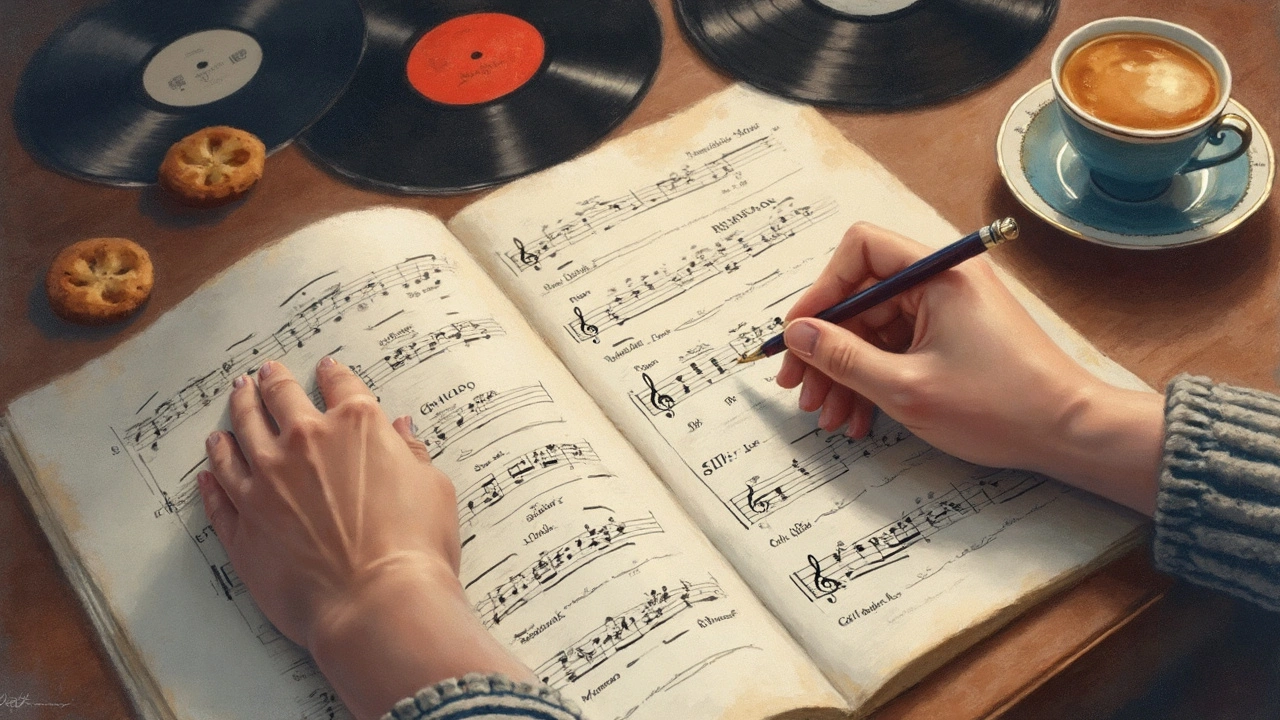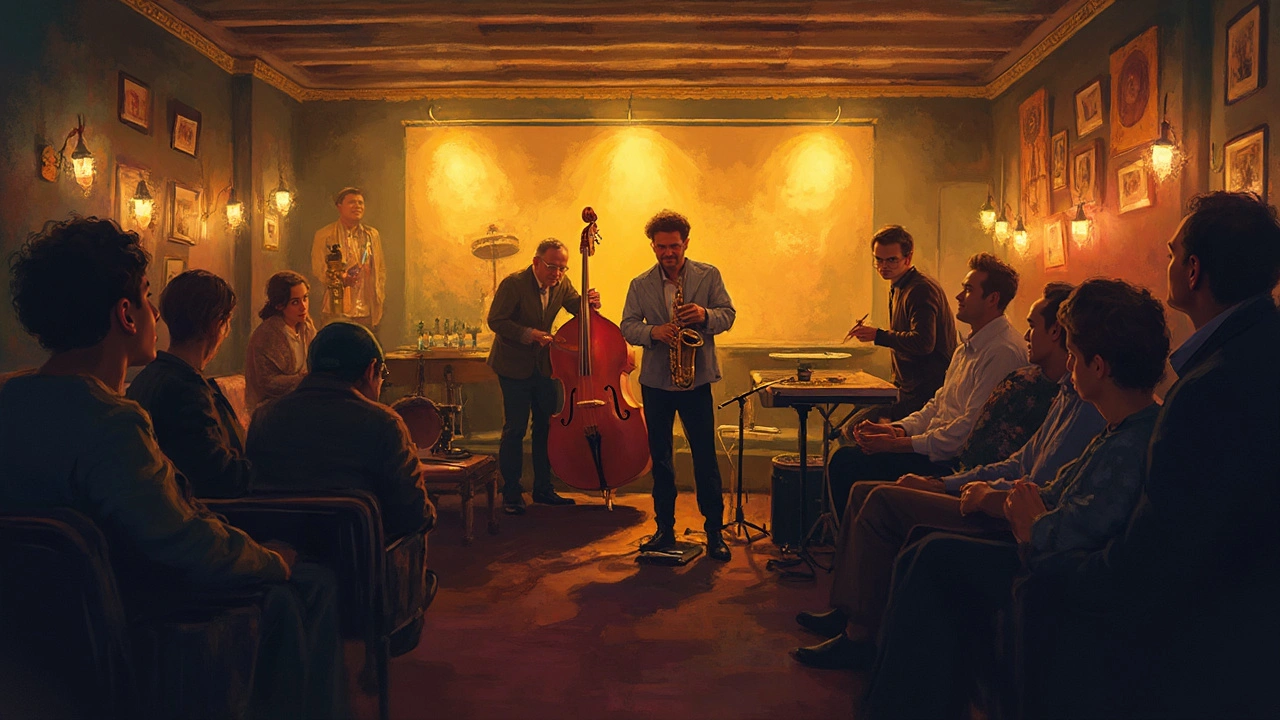If you’ve ever listened to jazz and thought, “What’s even happening here?”—you’re not alone. Jazz likes to break the rules, so the first tip is to toss out everything you expect from other music. It’s not about repeating choruses or straightforward beats; it’s more about what the musicians do in the moment. The cool part? You don’t need to know a bunch of music theory to enjoy it.
One thing that makes jazz stand out is improvisation. That’s just musicians making it up as they go, like a conversation without a script. It means every performance is a little different, and the players are always listening to each other. Try listening for those moments when the band seems to surprise even themselves. It’s a great way to start picking up on jazz’s playful side.
Forget about trying to catch every single note. Try to focus on the energy—a swinging beat, a trumpet solo that seems to wander and then snap back, or that long moment when everyone sounds like they’re on the edge of chaos, but it all comes together. If you get lost, that’s normal. Jazz isn’t about perfect understanding. It’s about how it makes you feel in the moment.
- What Makes Jazz Unique
- How to Listen Like a Jazz Fan
- Building Your Starter Playlist
- Getting More from Live Jazz and Classics
What Makes Jazz Unique
Jazz isn’t just one style; it’s more like a big family of sounds that’s always changing. What really sets it apart from other music is a mix of improvisation, syncopation, and something called “swing.” If you grab any classic jazz record, you’ll notice musicians adding their own spin and playing around with timing. That’s baked right into the genre. Jazz came out of New Orleans in the early 1900s—born from blues, ragtime, and a blend of African and European musical traditions. That’s why it feels both familiar and different at the same time.
Improvisation is the main show here. While the band might start with a simple melody, every player messes with it, making up new lines as they go. It’s like a group chat where everyone gets a turn. This is one reason why the same song can sound wildly different from one performance to the next.
Another jazzy thing is syncopation—putting emphasis on unexpected beats or spaces. This offbeat energy makes your head nod, even if you didn’t mean to. And then there’s “swing,” which is hard to describe but easy to feel—it’s this bouncy, uneven groove that makes jazz so fun to listen to.
Jazz is also known for having some legendary names and styles. Here’s a quick comparison of popular jazz eras and what makes each stand out:
| Era | Main Features | Famous Artists |
|---|---|---|
| New Orleans (1910s-1920s) | Group improvisation, simple melodies | Louis Armstrong, Jelly Roll Morton |
| Swing (1930s-1940s) | Big bands, strong rhythms, danceable beats | Duke Ellington, Count Basie |
| Bebop (1940s-1950s) | Fast tempos, complex solos, less focus on dancing | Charlie Parker, Dizzy Gillespie |
| Cool/Hard Bop (1950s-1960s) | Relaxed (cool) or punchy (hard bop) moods | Miles Davis, Art Blakey |
| Modern/Contemporary (1970s-now) | Electric instruments, blends with rock, funk, hip hop | Herbie Hancock, Esperanza Spalding |
One more thing: jazz doesn’t just live in history books. Every year, hundreds of jazz festivals pop up worldwide and jazz is taught in more than 500 U.S. colleges. The jazz scene is alive and still growing, so what makes jazz unique is a mix of past and present, freedom, and a connection you can feel in the music.
How to Listen Like a Jazz Fan
Listening to jazz isn’t just about hearing background music at a restaurant. When you pay attention, there’s a lot to catch. Start with the basics: jazz is built on improvisation, swing rhythms, and a call-and-response vibe. Most famous jazz recordings, like Miles Davis' "Kind of Blue" or John Coltrane's "A Love Supreme," are full of on-the-spot choices you can actually hear if you know what to listen for.
First, focus on the instruments. Each one usually gets a turn to “speak”—this is called a solo. It’s not random playing; soloists riff on familiar tunes, then add their own spin. Meanwhile, the rest of the band keeps the groove going underneath, known as “comping.” You can follow the ride if you pay attention to how the piano, bass, and drums support the solo.
- Jazz isn’t just about solos—listen for the group chemistry. Bands like the Modern Jazz Quartet or the Dave Brubeck Quartet have tight teamwork, passing energy back and forth.
- Try focusing on the rhythm. Jazz often uses syncopation, meaning beats show up unexpectedly. You might find yourself tapping along to a beat that jumps around instead of sticking to the usual count.
- If you’re new, start with vocal jazz like Ella Fitzgerald or Billie Holiday—the lyrics and melody can be a good anchor while you get used to everything happening in the background.
Here’s a neat way to practice: pick one instrument per song. On your next listen, just follow the bass line or the drum patterns. You’ll start to catch little twists you missed before. Don’t worry about understanding every technical detail—just notice the layers and conversation between players.
| Artist | Album | Approx. US Sales |
|---|---|---|
| Miles Davis | Kind of Blue | 5 Million+ |
| Dave Brubeck | Time Out | 2 Million+ |
| John Coltrane | A Love Supreme | 1 Million+ |
Finally, listen to live recordings when you can. The crowd energy, raw sound, and longer solos show off the real spirit of jazz. It’s not about getting everything right. It’s about catching the energy and back-and-forth that makes each performance feel new.

Building Your Starter Playlist
Nothing speeds up your jazz education like a solid playlist, so here’s where you roll up your sleeves. Don’t worry—you don’t need to start with deep cuts. The goal here is to find tracks that give you a real taste of what makes jazz music pop, from smooth swing to wild improvisation. You’ll cover different eras and styles, just enough to spot what you like best.
Start with the classics. If it’s your first round, these songs and artists will give you the strongest sense of what jazz is all about:
- “So What” by Miles Davis – Laid-back cool jazz, super recognizable riff.
- “Take Five” by Dave Brubeck Quartet – Famous for its tricky time signature, but the melody is catchy.
- “My Favorite Things” by John Coltrane – An upbeat twist on a well-known tune, loads of improvisation.
- “A Night in Tunisia” by Dizzy Gillespie – This is classic bebop with punchy horns and loads of energy.
- “Sing, Sing, Sing” by Benny Goodman – Big band swing with a driving beat you can’t miss.
Don’t be afraid to mix in more modern artists, too.
- “I’m Not in Love” by Brad Mehldau – Modern piano jazz that even non-jazz fans find approachable.
- “Hat and Beard” by The Bad Plus – Fresh, creative, nothing like old-school stuff but totally accessible.
Here’s a quick look at why these tracks matter:
| Song | Artist | Why It’s on the List |
|---|---|---|
| So What | Miles Davis | Defines cool jazz, great starter for new listeners |
| Take Five | Dave Brubeck Quartet | Funky rhythm, unforgettable piano |
| My Favorite Things | John Coltrane | Iconic soloing, shows improvisation |
| A Night in Tunisia | Dizzy Gillespie | Bebop energy, tight group playing |
| Sing, Sing, Sing | Benny Goodman | Classic swing, huge influence on dance music |
The trick is to hit “play” in different moods or settings. Put these tracks into your favorite music app and try listening while you cook, drive, or even just sit with your headphones. Each time, something new might jump out—a strange rhythm, a wild solo, a moment when the whole band locks in together. As you play around, you'll notice what grabs you. That’s your sign to start digging deeper into those artists or styles.
Getting More from Live Jazz and Classics
Nothing beats hearing jazz live. Even if you listen to a hundred albums, being in the same room with musicians changes everything. You get to see how the band works together and throws ideas around—sometimes with just a look or a nod. It’s like watching a team sport, but the goal is to stir up new sounds rather than score points.
If you’ve never been to a live jazz show, start small—a local club, not a giant concert hall. The intimacy lets you catch the little things, like how the sax player might smile at the drummer right before taking off on a wild solo. For newbies, this is where you notice just how much improvisation is happening. One famous fact: no two jazz performances are ever exactly alike, even when playing the same song.
If you’re not near any clubs, look up live-streamed gigs or tiny desk concerts online. Some jazz bars in New Orleans and New York, like Blue Note or Preservation Hall, put their shows up on YouTube. Watching these, you’ll see that the audience is as much a part of the experience as the players. Don’t be afraid to clap mid-song when a solo knocks you out—jazz crowds love that.
Getting into jazz classics is another way to tune your ear. Start with famous albums that are easy to find, like Miles Davis’ “Kind of Blue,” John Coltrane’s “A Love Supreme,” or Ella Fitzgerald Live at Newport. These recordings turned a lot of people from casual listeners into lifelong fans. Notice how the older records sound a little raw—back then, everything was recorded live in the room, without modern edits or fixes.
- Listen for call-and-response patterns between instruments—it’s like they’re talking.
- Try to notice when someone in the band pushes things in a new direction and how everyone else reacts.
- Read a bit about the history of your favorite recordings. Sometimes knowing the story behind an album or session makes it much more fun to hear.
- If you’re with friends, swap favorite tracks and see who hears what. Jazz is always better when it’s a shared discovery.
The more you catch shows and listen to the greats, the more jazz starts to open up. Over time, patterns jump out, solos make more sense, and even the weirdest sounds feel part of something bigger. That’s when jazz hooks you—and it’s a feeling you won’t forget.

